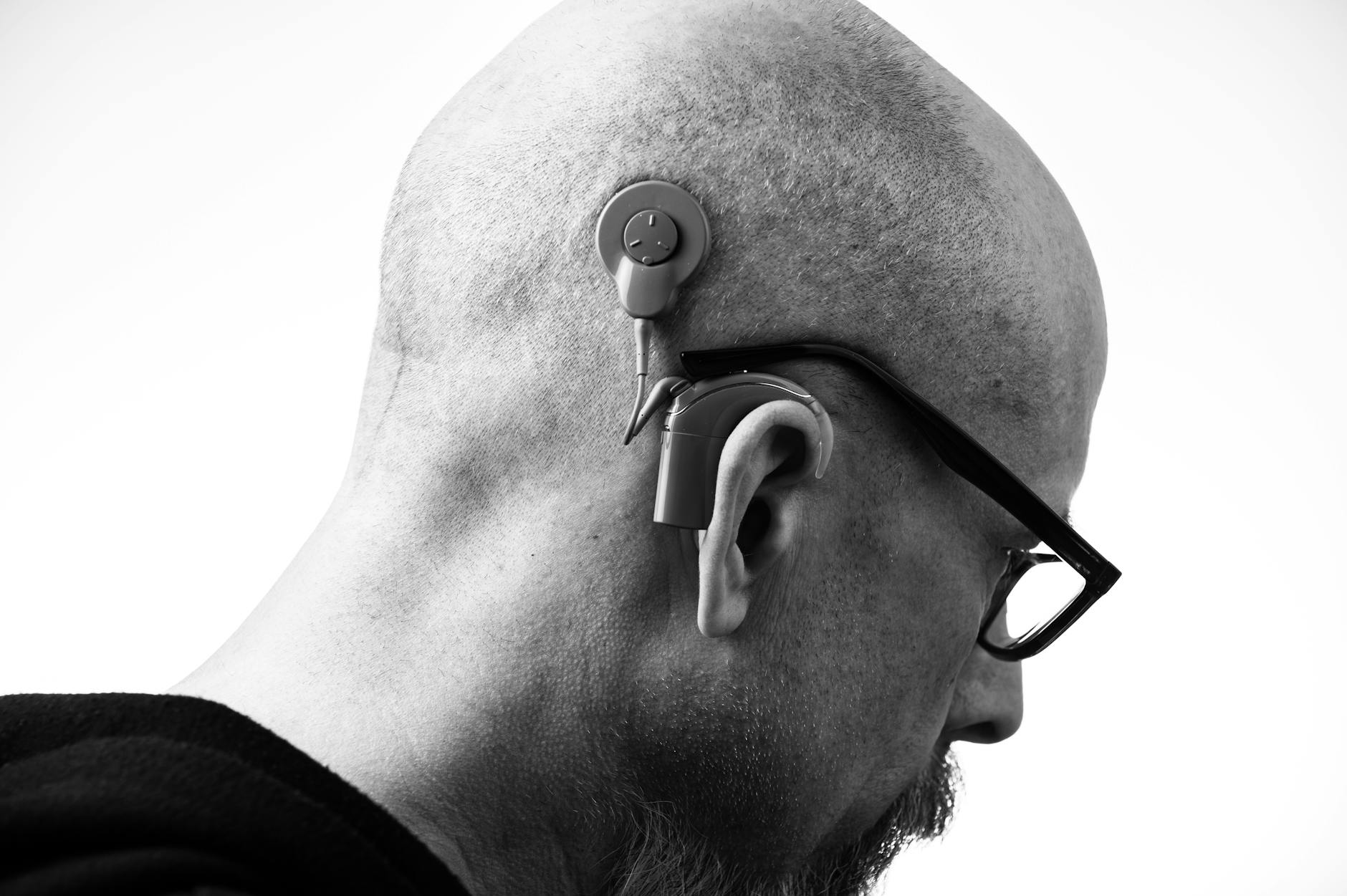If your tinnitus gets louder when you clench your teeth, turn your head, or press on a neck muscle, your body is telling you something important: the ringing might be getting a boost from your neck and jaw. The good news? Calming those “feeders” often calms the sound. Here’s a clear, practical plan you can start today—plus when to bring in an audiologist, physical therapist, and dentist as your A-team.
Is Your Tinnitus Somatosensory?
Somatosensory (or “somatic”) tinnitus means non-auditory signals from your neck, jaw, or face are interacting with your auditory system and nudging the volume, pitch, or quality of the ringing. This doesn’t mean your tinnitus is “all in your muscles,” but it does mean your body may be giving it a megaphone.
Quick self-check (30 seconds)
- Gently clench your teeth or push your jaw forward. Does the sound change?
- Turn your head left/right or tuck your chin. Any shift in pitch or loudness?
- Press lightly on tight spots in your jaw (masseter) or side of neck (sternocleidomastoid). Notice any modulation?
If you can reliably change your tinnitus with movements or pressure, there’s a decent chance a somatosensory component is in the mix. That’s useful, because it points to treatments that focus on the neck/jaw alongside sound therapy and counseling.
Why the Neck and Jaw Talk to Your Ears
Your hearing pathways don’t live in a vacuum. Sensory nerves from the jaw (trigeminal) and upper neck (cervical) plug into auditory processing hubs, including the dorsal cochlear nucleus. Muscle tension, joint irritation, or nerve sensitization can alter that input, sometimes “coloring” the tinnitus you hear.
- Jaw/TMJ drivers: clenching, grinding (bruxism), gum chewing, hard foods, misalignment, or injury.
- Neck drivers: forward-head posture, long desk time, past whiplash, tight suboccipitals and upper trapezius.
- Stress link: stress ramps clenching and neck guarding, which can spike both tinnitus loudness and distress.
The takeaway: Calming jaw/neck tension and improving movement can reduce the “boost” to your tinnitus—often within weeks.
Treatment Game Plan: Calm the Feeders, Calm the Ringing
Pair gentle body work with smart sound enrichment and professional support. Aim for steady, low-effort routines you can actually keep.
The 10-minute daily reset
- Jaw drop and tongue rest (1 minute): Place the tip of your tongue on the ridge behind your front teeth and let your jaw hang slightly open. Breathe through your nose. This is your no-clench “home base.”
- Nasal breathing + slow exhale (1 minute): Inhale 4 seconds, exhale 6–8 seconds. Relax your shoulders. This can dial down clenching and soften tinnitus reactivity.
- Chin tucks (1 minute): Seated tall, glide your head straight back (double-chin motion) without tilting. Hold 3 seconds, repeat 8–10 times. Gentle only.
- Upper trap and levator stretch (2 minutes): Sit tall. Tilt ear toward shoulder, then gently nose-down toward armpit. Hold 20–30 seconds each side.
- Pec doorway stretch (1–2 minutes): Forearms on doorframe, step through to open the chest. Keep head neutral.
- Masseter and jaw line self-release (2–3 minutes): With a relaxed jaw, use fingertips to gently sweep and press along the cheek (masseter) and temple (temporalis). Hold tender points 20–30 seconds at a 3/10 pressure. Stop if pain or dizziness increases.
Tip: Consistency beats intensity. The goal is less guarding, more easy movement.
TMJ-smart habits (especially if you clench)
- Adopt N–T–R: Nose breathe, Tongue on roof, Relaxed jaw. Check in hourly.
- Soft-food phases: During flares, choose softer foods and avoid big bites, nuts, jerky, or chewy candy for 1–2 weeks.
- Skip gum and hard mints: They feed clenching loops.
- Yawning and laughing: Support your jaw lightly with a hand to avoid wide opening.
- Heat before bed: 10–15 minutes of warm compress at the jaw and base of skull can reduce night clenching.
Neck-friendly desk setup
- Screen at eye height; sit tall with hips slightly higher than knees.
- Elbows supported; keep the phone off your shoulder.
- Micro-breaks every 30–45 minutes: 60 seconds of chin tucks + shoulder rolls.
Sound enrichment still matters
Even with a strong somatosensory component, your brain responds well to gentle sound. Try low-level broadband sound (fan, soft nature sounds, sound pillow) especially in quieter settings or at bedtime. If you have hearing loss, well-fitted hearing aids often reduce tinnitus burden by restoring missing sound. An audiologist can tailor sound therapy and counseling to make habituation easier.
Bring in the pros (your A-team)
- Audiologist: Tinnitus assessment, hearing test, sound therapy, and coping strategies. Ask about wearable sound generators or hearing aids if appropriate.
- Physical therapist (PT) with TMJ/cervical training: Manual therapy, muscle re-education, mobility, and a personalized plan. Share which movements modulate your tinnitus.
- Dental professional (TMJ-aware): Evaluate bruxism/TMJ disorder. A custom night splint can reduce jaw load; avoid irreversible dental procedures marketed as “tinnitus cures.”
- ENT/otology: Rule out ear disease and guide next steps, especially if you have red flags (see below).
A Two-Week Starter Plan
Use this as a framework—your PT or audiologist can personalize it.
- Morning (5–8 minutes): Jaw drop/tongue rest, chin tucks, doorway stretch. Set a “no-clench” reminder on your phone.
- Workday micro-breaks (60–90 seconds, 4–6 times/day): Chin tucks, shoulder rolls, slow exhale, quick masseter sweep.
- Evening (8–12 minutes): Heat pack, neck stretches, gentle self-release to masseter/temple/suboccipitals, brief sound enrichment during wind-down.
- Bedtime: Sound pillow or soft bedside sound. If you have a splint, wear it.
Track what modulates your tinnitus (movements, foods, stress, sleep). Look for trends over 14 days—this helps your clinicians fine-tune care.
What Results to Expect (and When)
- Timeline: Many people notice less reactivity within 2–4 weeks of consistent tissue calming and posture work. More durable gains often build over 6–8 weeks.
- Outcomes: Studies on cervical/TMJ-focused therapy suggest improvements in tinnitus loudness and annoyance for a meaningful subset, especially when modulating signs are present. Your mileage varies—think “volume dial,” not on/off switch.
- Keep going: Reducing distress (sleep, sound therapy, CBT-informed coping) can lower the brain’s threat response to tinnitus, amplifying body-based gains.
Safety Notes and Red Flags
- Exercises should be gentle and pain-free. If symptoms spike, scale back and consult a professional.
- Stop and seek medical care promptly if you notice any of the following: sudden hearing loss in one ear, new one-sided tinnitus with a feeling of ear fullness or vertigo, pulsatile (heartbeat-like) tinnitus, or new neurological symptoms. An otolaryngologist (ENT) can evaluate urgent causes.
Frequently Overlooked Helpers
- Sleep: 7–9 hours helps muscles recover and reduces clench risk. Keep caffeine earlier in the day.
- Stress skills: Brief daily relaxation (box breathing, guided imagery) lowers muscle guarding and tinnitus reactivity.
- Activity: Gentle aerobic movement (walking, cycling) improves circulation and pain thresholds.
Putting It Together
Somatosensory tinnitus is treatable territory—not by chasing a single “fix,” but by steadily turning down the body’s extra input and helping the brain feel safe. Start with the 10-minute reset, use sound enrichment, and line up your A-team. An audiologist can help you measure progress, personalize sound therapy, and coordinate with PT and dental care. Small, steady steps can make today’s ringing feel a lot more manageable.
Further Reading
- When Everyday Sounds Hurt: Calm Hyperacusis Safely with Sound Therapy, CBT, and Smarter Protection (Treatment) - When Everyday Sounds Hurt: Treating Hyperacusis with Gentle Sound and Calm Brain (Treatment) - When Your Neck or Jaw Makes Noise: Treating Somatosensory Tinnitus (Treatment) - Tinnitus, Trained: CBT, Sound Therapy, and Habits That Actually Help (Treatment)Frequently Asked Questions
Can I make my tinnitus worse with jaw or neck exercises?
Go gently and pain-free. The goal is relaxation and easy movement, not aggressive stretching or hard pressure. If a move increases pain, dizziness, or ringing, stop and scale back. A physical therapist trained in TMJ/cervical care can tailor safe progressions for you.
How do I know if a night guard will help my tinnitus?
If you clench or grind, a custom dental splint can reduce jaw load and sometimes lower tinnitus reactivity. Over-the-counter guards are a temporary option but may change your bite; a dentist trained in TMJ care can fit and monitor a custom splint. Guards are one piece of the puzzle—pair with posture, relaxation, and sound therapy.
Do I still need an audiologist if my tinnitus is clearly modulated by jaw or neck movement?
Yes. Even with a strong somatosensory component, an audiologist can check your hearing, guide sound therapy, and track progress. If you have hearing loss, properly fitted hearing aids often reduce tinnitus burden and improve communication.
Are medications useful for somatosensory tinnitus?
There’s no medication that reliably stops tinnitus. Short-term options may help with related issues (e.g., pain flares, sleep), but they don’t treat the underlying modulation. Non-drug strategies—PT, jaw care, sound therapy, and CBT-informed coping—have the strongest support. Discuss any medication decisions with your clinician.
References
- NIDCD – Tinnitus (Overview)
- American Academy of Otolaryngology—Head and Neck Surgery – Clinical Practice Guideline: Tinnitus (2014; updates)
- Michiels S, et al. The Effect of Physical Therapy Treatment in Patients with Subjective Tinnitus: A Systematic Review
- Mayo Clinic – TMJ disorders
- De Ridder D, et al. Review: An Integrative Model of Tinnitus (Somatosensory influences)



